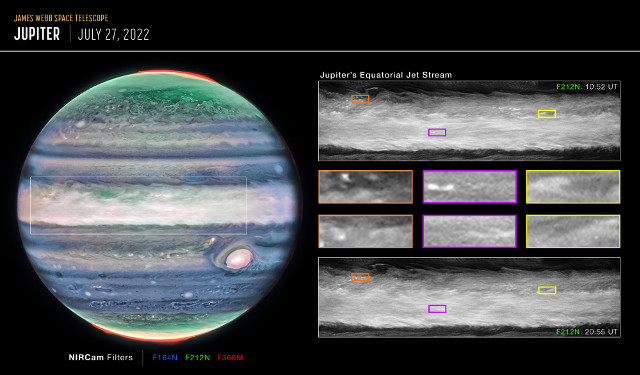
An article published in the journal “Nature Astronomy” reports the discovery of an equatorial jet stream traveling at over 500 kilometers per hour in the lower layers of the stratosphere of the planet Jupiter extending for almost 5,000 kilometers. A team of researchers analyzed data collected by the James Webb Space Telescope’s NIRCam (Near-Infrared Camera) instrument during observations conducted in July 2022 to obtain details of the winds that include so-called wind shears, sudden variations in intensity and direction with altitude or distance. Data collected with the Hubble Space Telescope provided additional information about the atmosphere of Jupiter’s equator and other phenomena in that area useful in determining the characteristics of the jet stream.
The image (NASA, ESA, CSA, STScI, Ricardo Hueso (UPV), Imke de Pater (UC Berkeley), Thierry Fouchet (Observatory of Paris), Leigh Fletcher (University of Leicester), Michael H. Wong (UC Berkeley) , Joseph DePasquale (STScI)) shows Jupiter in an observation with the NIRCam instrument and in the insets some progressive zooms showing various wind shears at altitudes between 20 and 35 kilometers above in Jupiter’s clouds.
Jupiter has been studied in recent years with very powerful instruments from Earth and from its orbit, where NASA’s Juno space probe is conducting its mission. Despite this, astronomers have always seen certain areas of Jupiter’s atmosphere as fuzzy hazes. The James Webb Space Telescope allowed them to obtain never-before-seen details that surprised the researchers.
The Hubble Space Telescope can’t probe Jupiter’s atmosphere like Webb, but observations conducted a day after Webb’s were still crucial. That’s because the data collected by Hubble made it possible to determine the basic state of the Jovian equatorial atmosphere and observe the development of convective storms in the equatorial area not connected to the newly discovered jet stream.
The combination of the observations made it possible to identify the jet stream in what other instruments consider to be a hazy area. By comparing the winds observed by Webb at high altitudes, to the winds observed at deeper layers from Hubble, the researchers were able to measure how quickly the speed of the winds changed with altitude, generating wind shears. The jet stream discovered by Webb was found to travel at over 500 kilometers per hour in Jupiter’s lower stratosphere, about 40 kilometers above the clouds.
This discovery adds new information about the winds in Jupiter’s stratosphere. Normally, the planet has patterns of winds and temperatures that repeat over time, which means that if the newly discovered jet stream is linked to this pattern, it’s expected to vary significantly over a period of two to four years. The answer will come from future observations and in any case, will allow to improve models regarding the Jovian weather.
All weather information on Jupiter helps to understand the processes taking place in its atmosphere with the similarities and differences compared to Saturn. The models that are developed and refined help study gas giant exoplanets, where conditions are very different from those existing on Earth.

